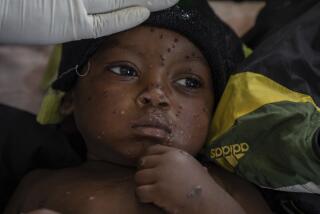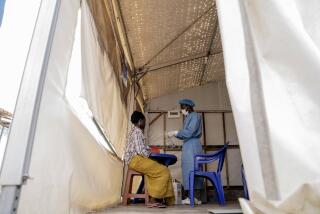HIV’s spread traced back to 1920s Kinshasa
Long before scientists discovered its role in a mysterious disease affecting gay men and intravenous drug users, the world’s most virulent strain of HIV had already begun its grim career in Belgian colonial Africa, according to new research.
In a paper published recently in the journal Science, researchers argued that HIV-1 group M -- the strain of HIV responsible for about 90% of infections worldwide -- first appeared in the city of Leopoldville, or what is now Kinshasa, in the 1920s.
Using statistical methods and genetic sequencing data, researchers determined that the disease spread through what is now the Democratic Republic of Congo via poor medical practices and through the interaction of sex workers and miners.
Study author Dr. Jacques Pepin, an infectious disease expert at Canada’s University of Sherbrooke, said the use of improperly sterilized hypodermic needles at a Leopoldville STD clinic was likely responsible for a number of these early infections, as well as the spread of other blood-borne diseases.
“Many of the patients treated at this clinic were sex workers, but there were also male patients with STDs, migrants and women who were not sex workers,” Pepin said.
From Kinshasa, infected individuals traveled along newly constructed rail lines to major mining locations as the diamond and mineral trade grew.
Study authors estimate that by 1937, HIV had spread to the nearby city of Brazzaville and to the southern mining centers of Lubumbashi and Mbuji-Mayi.
It took longer, however, for the strain to spread north: In 1946 it reached Bwamanda and by 1953 it reached Kisangani, authors wrote.
By 1960, spread of the virus had become exponential, although nobody realized it.
Then, in 1964, the virus crossed the Atlantic and landed in Haiti, researchers say.
“It has been suggested this occurred with the return of Haitian professionals who worked in the newly independent Congo in the 1960s,” the authors wrote. “Our results strengthen this hypothesis, as a large proportion of these professionals were based in Kinshasa.”
It would not be until 1983 that scientists would isolate the virus. To date, it has infected 75 million people worldwide.
Researchers hypothesize that the ancestor to the group M virus was a form of HIV that was endemic to chimpanzees. The virus presumably jumped to humans when infected chimps were hunted for food in the area of southeast Cameroon, they wrote
“The virus probably traveled via ferry along the Sangha River system to Kinshasa,” study authors wrote.
They suggest that this transmission may have taken place during the German colonization of Cameroon, between 1884 and 1916. “Connections between southern Cameroon and Kinshasa were frequent due to the exploitation of rubber and ivory,” authors wrote.
However, some researchers believe the virus made the jump to humans much earlier.
“To say that this started around the 1920s just doesn’t wash with me,” said Dr. Joseph McCormick, a viral disease expert at the University of Texas Health Science Center at Houston, who was not involved in the study.
McCormick said the broad diversity of HIV strains in Africa suggests that the virus had been developing and evolving for a very long time.
“I think it happened when people started hunting chimpanzees, and that was a hell of a long time ago,” he said.
Authors of the Science study acknowledged that debate was likely to continue on the matter.
“Hypotheses concerning the geographic source of the pandemic and its early dissemination in humans remain controversial and have yet to be formally tested,” they wrote.
Follow @montemorin for science news.







